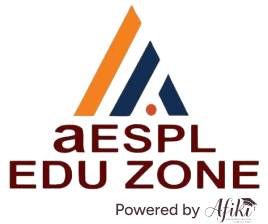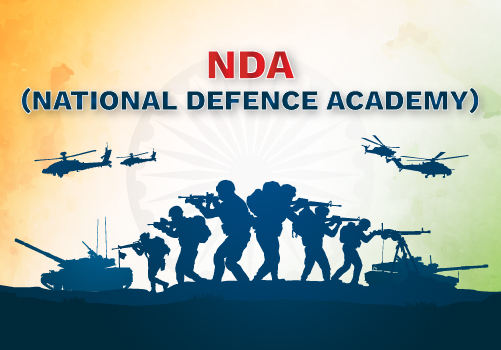NDA (National Defence Academy)
Defence/NDA-
2Sessions
-
1008Content
-
21Mock Test
Key Highlights
- Video Lectures
- PDF Notes
- Practice Questions
- Mock Tests
Overview
Before the syllabus first check the important points of the NDA Syllabus and Exam Pattern in the table below.
|
Subject |
Topics |
|
Mathematics |
Algebra: Sets, Venn diagrams, De Morgan laws, Cartesian product,
relation, equivalence relation. Real numbers, Complex numbers, Modulus, Cube
roots, Conversion of a number in Binary system to Decimals, and vice-versa.
Arithmetic, Geometric and Harmonic progressions. Quadratic equations, Linear
in equations, Permutation and Combination, Binomial theorem, and Logarithms. Calculus: Concept of a real-valued function, domain, range, and graph
of a function. Composite functions, one-to-one, onto, and inverse functions.
The notion of limit, Standard limits, Continuity of functions, algebraic
operations on continuous functions. Derivative of function at a point,
geometrical and physical interpretation of a derivative application.
Derivatives of sum, product, and quotient of functions, a derivative of a
function concerning another function, the derivative of a composite function.
Second-order derivatives. Increasing and decreasing functions. Application of
derivatives in problems of maxima and minima Matrices and Determinants: Types of matrices, operations on matrices.
Determinant of a matrix, basic properties of determinants. Adjoint and
inverse of a square matrix, Applications-Solution of a system of linear
equations in two or three unknowns by Cramer’s rule and by Matrix Method. Integral Calculus and Differential Equations: Integration as inverse
of differentiation, integration by substitution and by parts, standard
integrals involving algebraic expressions, trigonometric, exponential, and
hyperbolic functions. Evaluation of definite integrals—determination of areas
of plane regions bounded by curves—applications. Definition of order and
degree of a differential equation, formation of a differential equation by
examples. General and particular solution of differential equations, solution
of the first order, and first-degree differential equations of various
types—examples. Application in problems of growth and decay. Trigonometry: Angles and their measures in degrees and radians.
Trigonometric ratios. Trigonometric identities Sum and difference formulae.
Multiple and Sub-multiple angles. Inverse trigonometric functions.
Applications-Height and distance, properties of triangles. Vector Algebra Vectors in two
and three dimensions, magnitude, and direction of a vector. Unit and null
vectors, the addition of vectors, scalar multiplication of a vector, scalar
product, or dot product of two vectors. Vector product or cross product of
two vectors. Applications—work done by a force and moment of a force and in
geometrical problems. Analytical Geometry Of Two and Three Dimension: Rectangular Cartesian
Coordinate system. Distance formula. Equation of a line in various forms. The
angle between two lines. Distance of a point from a line. Equation of a
circle in standard and a general form. Standard forms of parabola, ellipse,
and hyperbola. Eccentricity and axis of a conic. Point in a three-dimensional
space, the distance between two points. Direction Cosines and direction
ratios. Equation two points. Direction Cosines and direction ratios. Equation
of a plane and a line in various forms. The angle between two lines and the
angle between two planes. Equation of a sphere. Statistics and Probability: Probability: Random experiment, outcomes,
and associated sample space, events, mutually exclusive and exhaustive
events, impossible and certain events. Union and Intersection of events.
Complementary, elementary, and composite events. Definition of
probability—classical and statistical—examples. Elementary theorems on
probability—simple problems. Conditional probability, Bayes’ theorem—simple
problems. Random variable as function on a sample space. Binomial
distribution, examples of random experiments giving rise to Binomial
distribution. |
|
Physics |
Physical Properties and States of Matter Modes of transference of Heat Mass, Weight, Volume, Sound waves and their properties Simple musical instruments Rectilinear propagation of Light Density and Specific Gravity Reflection and refraction Principle of Archimedes Spherical mirrors and Lenses Pressure Barometer Human Eye Motion of objects Natural and Artificial Magnets Velocity and Acceleration Properties of a Magnet Newton’s Laws of Motion Earth as a Magnet Force and Momentum Static and Current Electricity Parallelogram of Forces Conductors and Non-conductors Stability and Equilibrium of bodies Ohm’s Law Gravitation Simple Electrical Circuits Elementary ideas of work Heating, Lighting, and Magnetic effects of Current Power and Energy Measurement of Electrical Power Effects of Heat Primary and Secondary Cells Measurement of Temperature and Heat Use of X-Rays General Principles in the working of Simple Pendulum, Simple Pulleys,
Siphon, Levers, Balloon, Pumps, Hydrometer, Pressure Cooker, Thermos Flask,
Gramophone, Telegraphs, Telephone, Periscope, Telescope, Microscope,
Mariner’s Compass; Lightning Conductors, Safety Fuses. |
|
Chemistry |
Preparation and Properties of Hydrogen, Oxygen, Nitrogen and Carbon
Dioxide, Oxidation and Reduction. Acids, bases and salts. Carbon— different forms Physical and Chemical Changes Fertilizers—Natural and Artificial Elements Material used in the preparation of substances like Soap, Glass, Ink,
Paper, Cement, Paints, Safety Matches, and Gunpowder Mixtures and Compounds Elementary ideas about the structure of Atom Symbols, Formulae, and simple Chemical Equation Atomic Equivalent and Molecular Weights Law of Chemical Combination (excluding problems) Valency Properties of Air and Water |
|
General studies |
Common Epidemics, their causes, and prevention Difference between the living and non-living Food—Source of Energy for man Basis of Life—Cells, Protoplasms, and Tissues Constituents of food Growth and Reproduction in Plants and Animals Balanced Diet Elementary knowledge of the Human Body and its important organs The Solar System—Meteors and Comets, Eclipses. Achievements of
Eminent Scientists |
|
History |
Forces shaping the modern world; Renaissance Exploration and Discovery; A broad survey of Indian History, with emphasis on Culture and
Civilisation Freedom Movement in India French Revolution, Industrial Revolution, and Russian Revolution War of American Independence, Impact of Science and Technology on Society Elementary study of Indian Constitution and Administration Concept of one World Elementary knowledge of Five Year Plans of India United Nations, Panchsheel, Panchayati Raj, Democracy, Socialism and Communism Role of India in the present world Co-operatives and Community Development Bhoodan, Sarvodaya, National Integration and Welfare State Basic Teachings of Mahatma Gandhi |
|
Geography |
The Earth, its shape and size Ocean Currents and Tides Atmosphere and its composition Latitudes and Longitudes Temperature and Atmospheric Pressure, Planetary Winds, Cyclones, and
Anticyclones; Humidity; Condensation and Precipitation Concept of time Types of Climate International Date Line Major Natural Regions of the World Movements of Earth and their effects Regional Geography of India Climate, Natural vegetation. Mineral and Power resources; Location and distribution of agricultural and Industrial activities Origin of Earth. Rocks and their classification Important Sea ports and main sea, land, and air routes of India Weathering—Mechanical and Chemical, Earthquakes and Volcanoes Main items of Imports and Exports of India |
Course content
NDA (National Defence Academy) Premium
-
2Sessions
-
634Videos
-
374Pdfs
The efficacy of a student's preparation is contingent upon both their current grade level and the specific examination they are gearing up for. To optimize their study regimen, our platform offers a comprehensive solution. Our content is meticulously curated to be highly interactive and of exceptional quality.
Video Lectures: Our online video lectures are meticulously recorded in 4k resolution. These lectures serve to enhance student engagement, thereby fostering academic achievement. When students are genuinely interested in the material, they are more likely to digest and retain it effectively.
PDF Notes: We prioritize the creation of concise notes that emphasize key points, ensuring ease of access, organization, and reference. This approach is designed to facilitate information retention, as it necessitates focused concentration and active listening, which in turn stimulate cognitive processes conducive to enhanced learning outcomes.
Practice Questions: Questions have long been regarded as a fundamental pedagogical tool employed by educators and mentors to evaluate students' comprehension, stimulate critical thinking, and foster a deeper understanding of the subject matter. Well-crafted questions serve to engender fresh insights, stimulate meaningful discussions, and encourage thorough exploration of the topic at hand.






